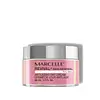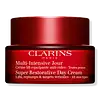What's inside
What's inside
 Key Ingredients
Key Ingredients

 Benefits
Benefits

 Concerns
Concerns

 Ingredients Side-by-side
Ingredients Side-by-side

Water
Skin ConditioningCocoglycerides
EmollientGlycerin
HumectantPropanediol
SolventButylene Glycol
HumectantCetyl Palmitate
EmollientPropylheptyl Caprylate
EmollientDicaprylyl Carbonate
EmollientPentaerythrityl Distearate
EmulsifyingGlyceryl Stearate
EmollientCetearyl Alcohol
EmollientPEG-100 Stearate
Cetearyl Glucoside
EmulsifyingGlyceryl Oleate
EmollientOctyldodecanol
EmollientCichorium Intybus Root Extract
MaskingVoandzeia Subterranea Seed Extract
Skin ConditioningEvodia Rutaecarpa Fruit Extract
Skin ConditioningHydrogenated Coco-Glycerides
EmollientGlyceryl Oleate Citrate
EmulsifyingSodium Polyacrylate
AbsorbentHelianthus Annuus Seed Extract
Skin ConditioningAscorbyl Palmitate
AntioxidantSodium Stearoyl Glutamate
CleansingAcetyl Dipeptide-1 Cetyl Ester
Skin ConditioningSorbitan Laurate
EmulsifyingLecithin
EmollientDimethicone
EmollientPEG-6
HumectantDisodium Phosphate
BufferingCitric Acid
BufferingXanthan Gum
EmulsifyingDimethiconol
EmollientHydroxyethylcellulose
Emulsion StabilisingTocopheryl Acetate
AntioxidantTocopherol
AntioxidantEthylhexylglycerin
Skin ConditioningPhenoxyethanol
PreservativeSorbic Acid
PreservativeSilica
AbrasiveIron Oxides
Water, Cocoglycerides, Glycerin, Propanediol, Butylene Glycol, Cetyl Palmitate, Propylheptyl Caprylate, Dicaprylyl Carbonate, Pentaerythrityl Distearate, Glyceryl Stearate, Cetearyl Alcohol, PEG-100 Stearate, Cetearyl Glucoside, Glyceryl Oleate, Octyldodecanol, Cichorium Intybus Root Extract, Voandzeia Subterranea Seed Extract, Evodia Rutaecarpa Fruit Extract, Hydrogenated Coco-Glycerides, Glyceryl Oleate Citrate, Sodium Polyacrylate, Helianthus Annuus Seed Extract, Ascorbyl Palmitate, Sodium Stearoyl Glutamate, Acetyl Dipeptide-1 Cetyl Ester, Sorbitan Laurate, Lecithin, Dimethicone, PEG-6, Disodium Phosphate, Citric Acid, Xanthan Gum, Dimethiconol, Hydroxyethylcellulose, Tocopheryl Acetate, Tocopherol, Ethylhexylglycerin, Phenoxyethanol, Sorbic Acid, Silica, Iron Oxides
Water
Skin ConditioningCaprylic/Capric Triglyceride
MaskingCetearyl Alcohol
EmollientSqualane
EmollientPentylene Glycol
Skin ConditioningGlycerin
HumectantHydrogenated Coco-Glycerides
EmollientAscorbyl Glucoside
AntioxidantButyrospermum Parkii Butter
Skin ConditioningGlyceryl Stearate
EmollientPEG-100 Stearate
Cetearyl Glucoside
EmulsifyingDimethicone
EmollientHydroxyethyl Acrylate/Sodium Acryloyldimethyl Taurate Copolymer
Emulsion StabilisingButylene Glycol
HumectantCarbomer
Emulsion StabilisingCaprylyl Glycol
EmollientSodium Hydroxide
BufferingSucrose Palmitate
EmollientXylitylglucoside
HumectantParfum
MaskingSodium Citrate
BufferingAnhydroxylitol
HumectantTocopheryl Acetate
AntioxidantCI 77891
Cosmetic ColorantSynthetic Fluorphlogopite
Dimethiconol
EmollientXylitol
HumectantGlyceryl Linoleate
EmollientDisodium EDTA
Polysorbate 60
EmulsifyingCitric Acid
BufferingSodium Lactate
BufferingSorbitan Isostearate
EmulsifyingGlucose
HumectantHarungana Madagascariensis Extract
Skin ConditioningMarrubium Vulgare Extract
Skin ConditioningPotassium Sorbate
PreservativePropanediol
SolventCoco-Glucoside
CleansingPectin
Emulsion StabilisingSodium Hyaluronate
HumectantBalanites Roxburghii Seed Oil
Skin ConditioningGuar Hydroxypropyltrimonium Chloride
Skin ConditioningPhenethyl Alcohol
MaskingFurcellaria Lumbricalis Extract
Skin ConditioningPancratium Maritimum Extract
BleachingUlex Europaeus Leaf/Root/Stem Extract
Skin ConditioningPalmitoyl Tripeptide-1
Skin ConditioningLapsana Communis Flower/Leaf/Stem Extract
Skin ConditioningMaris Sal
Skin ConditioningCI 14700
Cosmetic ColorantPalmitoyl Tetrapeptide-7
Skin ConditioningWater, Caprylic/Capric Triglyceride, Cetearyl Alcohol, Squalane, Pentylene Glycol, Glycerin, Hydrogenated Coco-Glycerides, Ascorbyl Glucoside, Butyrospermum Parkii Butter, Glyceryl Stearate, PEG-100 Stearate, Cetearyl Glucoside, Dimethicone, Hydroxyethyl Acrylate/Sodium Acryloyldimethyl Taurate Copolymer, Butylene Glycol, Carbomer, Caprylyl Glycol, Sodium Hydroxide, Sucrose Palmitate, Xylitylglucoside, Parfum, Sodium Citrate, Anhydroxylitol, Tocopheryl Acetate, CI 77891, Synthetic Fluorphlogopite, Dimethiconol, Xylitol, Glyceryl Linoleate, Disodium EDTA, Polysorbate 60, Citric Acid, Sodium Lactate, Sorbitan Isostearate, Glucose, Harungana Madagascariensis Extract, Marrubium Vulgare Extract, Potassium Sorbate, Propanediol, Coco-Glucoside, Pectin, Sodium Hyaluronate, Balanites Roxburghii Seed Oil, Guar Hydroxypropyltrimonium Chloride, Phenethyl Alcohol, Furcellaria Lumbricalis Extract, Pancratium Maritimum Extract, Ulex Europaeus Leaf/Root/Stem Extract, Palmitoyl Tripeptide-1, Lapsana Communis Flower/Leaf/Stem Extract, Maris Sal, CI 14700, Palmitoyl Tetrapeptide-7
Ingredients Explained
These ingredients are found in both products.
Ingredients higher up in an ingredient list are typically present in a larger amount.
Butylene Glycol (or BG) is used within cosmetic products for a few different reasons:
Overall, Butylene Glycol is a safe and well-rounded ingredient that works well with other ingredients.
Though this ingredient works well with most skin types, some people with sensitive skin may experience a reaction such as allergic rashes, closed comedones, or itchiness.
Learn more about Butylene GlycolCetearyl alcohol is a mixture of two fatty alcohols: cetyl alcohol and stearyl alcohol. It is mainly used as an emulsifier. Emulsifiers help prevent the separation of oils and products. Due to its composition, it can also be used to thicken a product or help create foam.
Cetearyl alcohol is an emollient. Emollients help soothe and hydrate the skin by trapping moisture.
Studies show Cetearyl alcohol is non-toxic and non-irritating. The FDA allows products labeled "alcohol-free" to have fatty alcohols.
This ingredient is usually derived from plant oils such as palm, vegetable, or coconut oils. There is debate on whether this ingredient will cause acne.
Due to the fatty acid base, this ingredient may not be Malassezia folliculitis safe.
Learn more about Cetearyl AlcoholCetearyl Glucoside is a surfactant and emulsifier. It can be produced from synthetic of natural sources of cetearyl alcohol and glucose.
Emulsifiers help prevent ingredients from separating, such as oils and waters. It can also be used to enhance the texture of products.
As a surfactant, Cetearyl Glucoside helps during the cleansing process. By gathering all the dirt and oils, it allows these molecules to be washed away easily.
Learn more about Cetearyl GlucosideCitric Acid is an alpha hydroxy acid (AHA) naturally found in citrus fruits like oranges, lemons, and limes.
Like other AHAs, citric acid can exfoliate skin by breaking down the bonds that hold dead skin cells together. This helps reveal smoother and brighter skin underneath.
However, this exfoliating effect only happens at high concentrations (20%) which can be hard to find in cosmetic products.
Due to this, citric acid is usually included in small amounts as a pH adjuster. This helps keep products slightly more acidic and compatible with skin's natural pH.
In skincare formulas, citric acid can:
While it can provide some skin benefits, research shows lactic acid and glycolic acid are generally more effective and less irritating exfoliants.
Most citric acid used in skincare today is made by fermenting sugars (usually from molasses). This synthetic version is identical to the natural citrus form but easier to stabilize and use in formulations.
Read more about some other popular AHA's here:
Learn more about Citric AcidDimethicone is a type of synthetic silicone created from natural materials such as quartz.
What it does:
Dimethicone comes in different viscosities:
Depending on the viscosity, dimethicone has different properties.
Ingredients lists don't always show which type is used, so we recommend reaching out to the brand if you have questions about the viscosity.
This ingredient is unlikely to cause irritation because it does not get absorbed into skin. However, people with silicone allergies should be careful about using this ingredient.
Note: Dimethicone may contribute to pilling. This is because it is not oil or water soluble, so pilling may occur when layered with products. When mixed with heavy oils in a formula, the outcome is also quite greasy.
Learn more about DimethiconeDimethiconol is a silicone that resembles the popular dimethicone. Like other silicones, it is an emollient. Emollients create a thin film on skin to prevent moisture from escaping.
This ingredient helps to create a silky texture and improve spreadability. Due to its high molecular weight and thickness, it is often combined with cyclopentasiloxane.
Glycerin is already naturally found in your skin. It helps moisturize and protect your skin.
A study from 2016 found glycerin to be more effective as a humectant than AHAs and hyaluronic acid.
As a humectant, it helps the skin stay hydrated by pulling moisture to your skin. The low molecular weight of glycerin allows it to pull moisture into the deeper layers of your skin.
Hydrated skin improves your skin barrier; Your skin barrier helps protect against irritants and bacteria.
Glycerin has also been found to have antimicrobial and antiviral properties. Due to these properties, glycerin is often used in wound and burn treatments.
In cosmetics, glycerin is usually derived from plants such as soybean or palm. However, it can also be sourced from animals, such as tallow or animal fat.
This ingredient is organic, colorless, odorless, and non-toxic.
Glycerin is the name for this ingredient in American English. British English uses Glycerol/Glycerine.
Learn more about GlycerinGlyceryl Stearate is a mix of glycerin and stearic acid.
It is used to stabilize the mixing of water and oil ingredients. By preventing these ingredients from separating, it can help elongate shelf life. It can also help thicken the product's texture.
As an emollient, it helps soften skin and supports barrier-replenishing ingredients.
In cosmetics, Glyceryl Stearate is often made from vegetable oils or synthetically produced.
This ingredient may not be fungal-acne safe
Fun fact: The human body also creates Glyceryl Stearate naturally.
Learn more about Glyceryl StearateHydrogenated Coco-Glycerides isn't fungal acne safe.
Peg-100 Stearate is an emollient and emulsifier. As an emollient, it helps keep skin soft by trapping moisture in. On the other hand, emulsifiers help prevent oil and water from separating in a product.
PEGS are a hydrophilic polyether compound . There are 100 ethylene oxide monomers in Peg-100 Stearate. Peg-100 Stearate is polyethylene glycol ester of stearic acid.
Propanediol is an all-star ingredient. It softens, hydrates, and smooths the skin.
It’s often used to:
Propanediol is not likely to cause sensitivity and considered safe to use. It is derived from corn or petroleum with a clear color and no scent.
Learn more about PropanediolTocopheryl Acetate is AKA Vitamin E. It is an antioxidant and protects your skin from free radicals. Free radicals damage the skin by breaking down collagen.
One study found using Tocopheryl Acetate with Vitamin C decreased the number of sunburned cells.
Tocopheryl Acetate is commonly found in both skincare and dietary supplements.
Learn more about Tocopheryl AcetateWater. It's the most common cosmetic ingredient of all. You'll usually see it at the top of ingredient lists, meaning that it makes up the largest part of the product.
So why is it so popular? Water most often acts as a solvent - this means that it helps dissolve other ingredients into the formulation.
You'll also recognize water as that liquid we all need to stay alive. If you see this, drink a glass of water. Stay hydrated!
Learn more about Water